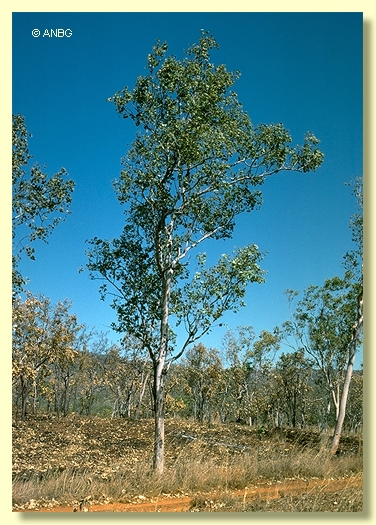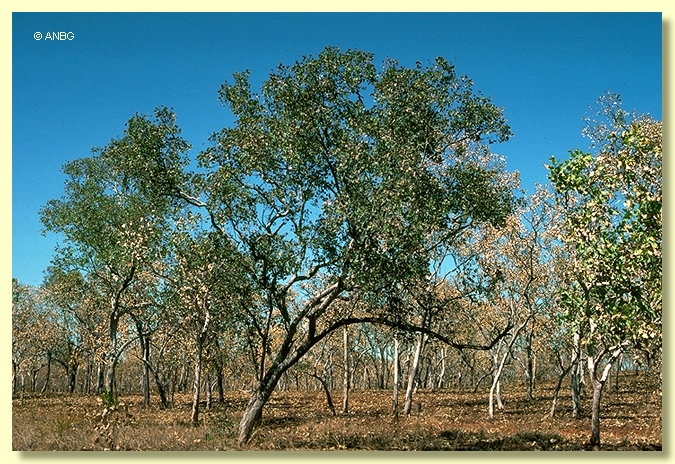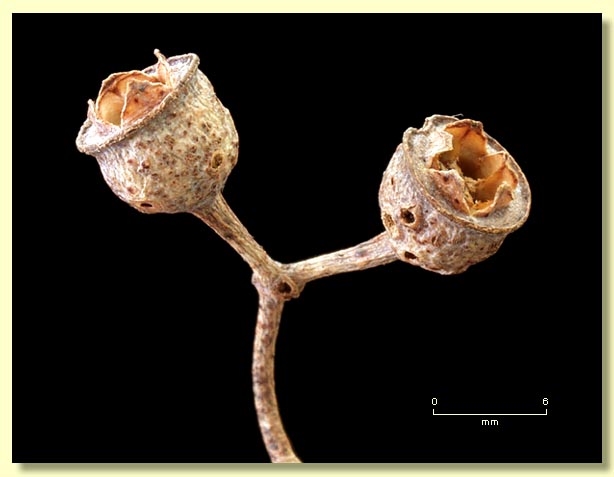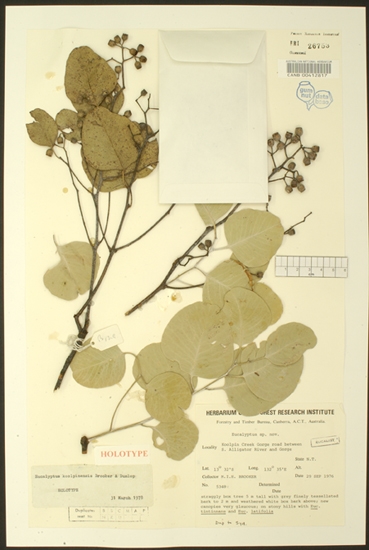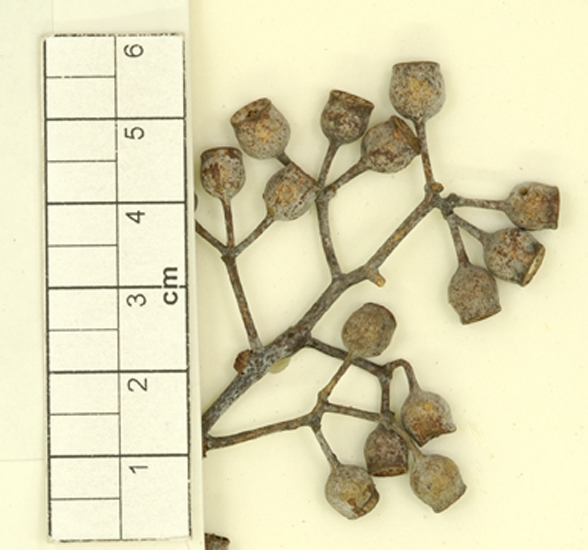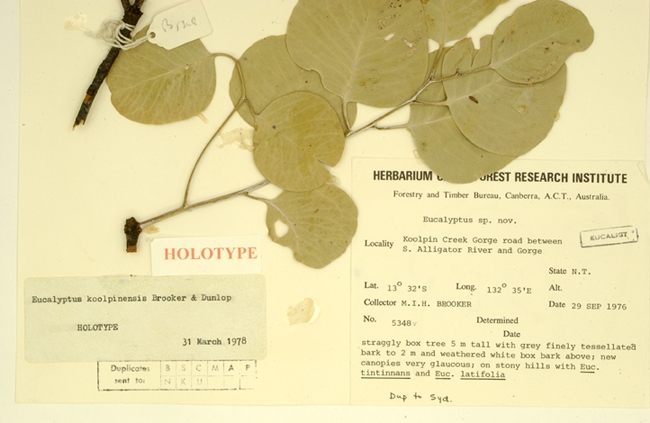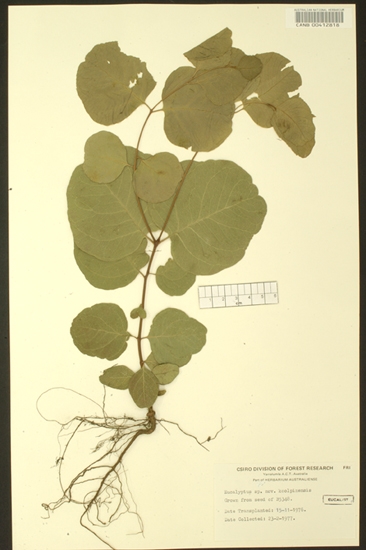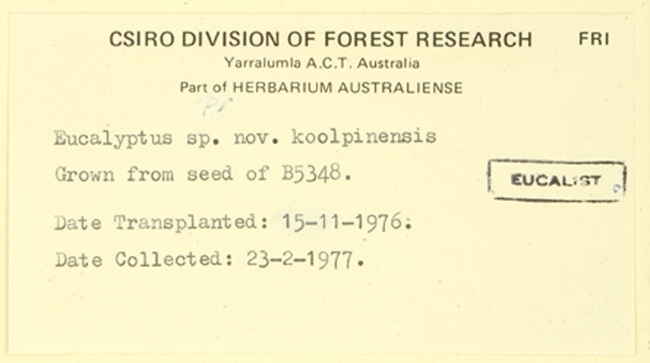Eucalyptus | Symphyomyrtus | Adnataria | Apicales | Aquilonares | Fortes
Euclid - Online edition
Eucalyptus koolpinensis
Straggly tree to 5 m, rarely to 12 m tall. Forming a lignotuber.
Bark rough to the ends of branches, tightly held box-type becoming tessellated on trunks, grey to grey-white.
Branchlets lack oil glands in the pith; glaucous.
Juvenile growth (coppice or field seedlings to 50 cm): stems rounded in cross-section, glaucous or not so; juvenile leaves always petiolate, alternate, orbicular to broadly ovate or deltoid, 4–9 cm long, 4.5–9 cm wide, base truncate to rounded or tapering, margin entire or irregular, apex rounded to emarginate or broadly pointed, bluish green.
Adult leaves alternate, petioles 1.3–3(3.8) cm long; blade orbicular to deltoid, 4–10 cm long, 3.5–8.5(12.5) cm wide, base truncate or tapering to petiole, margin entire or irregular, apex rounded or emarginate, less commonly pointed, concolorous, dull, glaucous to bluish green, side-veins at greater 45° to midrib, reticulation very dense, intramarginal vein present, oil glands apparently absent.
Inflorescence terminal compound, peduncles rounded, 0.5–2 cm long, buds 7 per umbel, pedicels 0.5–1.2 cm long. Mature buds pyriform, 0.7–0.9 cm long, 0.4–0.5 cm wide, glaucous, scar present (outer operculum shed early), operculum beaked, stamens irregularly flexed or mostly inflexed, all fertile, anthers adnate to filaments, basifixed, cuboid to globoid, dehiscing by short lateral slits, style long and straight, stigma blunt, locules 4, the placentae each with 4 vertical ovule rows. Flowers creamy white.
Fruit pedicellate (pedicels 0.5–1.2 cm long), usually cupular or sometime slightly urceolate, 0.5–0.8 cm long, 0.5–0.7 cm wide, glaucous, disc usually descending vertically or obliquely, valves 4, at rim level or slightly exserted.
Seeds dark brown, 1.5–3 mm long, flattened-ovoid, dorsal surface shallowly reticulate, hilum ventral.
Cultivated seedlings (measured at ca node 10): cotyledons reniform; stems rounded in cross-section; leaves always petiolate, opposite for 8–10 nodes then becoming sub-opposite to alternate, deltoid to orbicular, 3–6 cm long, 3.5–7 cm long, base truncate to tapering, margin subcrenulate, apex emarginate to rounded dull, bluish green.
Flowering has been recorded in May.
A small tree endemic to the Top End of the Northern Territory, occurring only in Kakadu National Park. It grows at the slope of a broken sandstone outcrop and the edge on the adjoining clay-loam plain. It is completely box-barked and has a glaucous crown of broad deltoid to orbicular leaves and glaucous buds in a terminal inforescence; juvenile leaves on coppice growth large, more or less orbicular and stand out in the ground layer..
Eucalyptus koolpinensis belongs in Eucalyptus subgenus Symphyomyrtus section Adnataria (the boxes) because the buds have two opercula, ovules are in four rows, seeds are flattened-ovoid, cotyledons are reniform, and anthers are rigid on the staminal filaments. Within section Adnataria, E. koolpinensis belongs to a subgroup of box species with tropical distribution, series Aquilonares subseries Fortes, having inflorescences terminal on the branchlets, adult leaves very densely reticulate and fruit that are not fragile and have valves more or less at rim level when dehisced.
It is closely related to the more widespread E. oligantha but differs in having smaller, glaucous leaves, buds and fruit.
Eucalyptus koolpinensis: referring to Koolpin Creek, Northern Territory.

